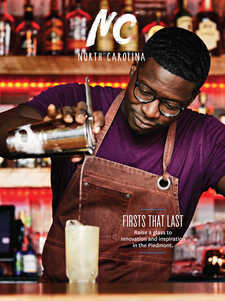Local Celebrity Profiles
- 22 Records Found
- (View All)
- |
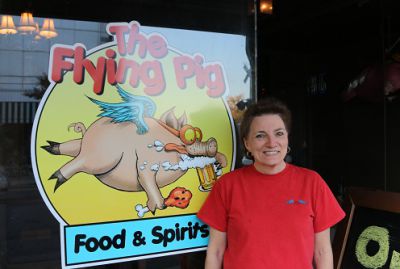
Barbara Gallimore | The Flying Pig Food & Spirits
[Perma Link]Previous NextBarbara Gallimore | The Flying Pig Food & Spirits

Q: The Flying Pig has been a successful restaurant in Asheboro ever since it opened, which is a great accomplishment considering most restaurants never even make it two years. How did it start, and have you always been in the restaurant business?
No, actually my husband Dennis and I, and our partners Barry & Mary Ann have always been in the business world, but none of us were in the restaurant business. We had talked a lot over the years about starting a business together so ironically when we opened, we didn’t know if it would succeed. In fact, we kept our day jobs at first just in case it did fail. Luckily it did succeed, and even faster than we ever imagined. It was only about half the size when we first opened but we quickly got the space next door and we have been doing great ever since, and now it’s our so-called real jobs!
Q: How did you come up with the name since you aren’t exactly a barbecue restaurant?
Well, there’s a couple of answers to this one, but the City of Asheboro was actually "dry" until 2008, meaning you could not serve alcohol. There was a popular saying, "Alcohol will be legalized in Asheboro when pigs fly.” After the bill was actually passed we kind of thought we may have a better chance at success with a restaurant bar, but honestly, we knew if we served alcohol it could backfire, too. Luckily to our benefit, we decided to go with a restaurant and bar and it all worked out.
Q: What are some of the most popular food and drink items on your menu?
We’re famous for our pizzas so that’s always on the menu; and as far as appetizers we have what we call Pig Squealing Nachos, Pig Wings, and Angry Okra – which is actually fried jalapenos. We’re also really proud of our homemade cheesecakes and pies. When it’s someone’s birthday, we give them a pig hat to wear and give them a cupcake...kids of all ages love that. We also have 16 beers on tap and we sell a ton of local beers which people love to support, plus the full bar.
Q: One of the most memorable things about The Flying Pig is the fact there is so much to look at! There are pigs and sports jerseys and paraphernalia everywhere. How did you collect all of these unique items?
That’s the craziest thing ever. We had a few items when we opened, but we have to credit most of our incredible collection of jerseys, pigs, and even our taxidermy animals to our great customers. They bring them to us all of the time, and we have so much more than what you see now. During different holidays we showcase themed pigs in our front window. Our customers love to see the Christmas hats, Valentine’s Day and Saint Patrick’s Day outfits. It makes them feel part of the community and part of our establishment when they come in and see the hat or item they gave us to display.
Q: What do you love most about this area?
I absolutely love being in downtown Asheboro. They have done such an amazing job revitalizing this area. Just ten years ago this place was a virtual ghost town, and now it’s thriving. I love that the city has chosen to keep its old buildings and its sense of history. We refurbish our buildings; we don’t tear them down. I love the old wood floors and walls, they speak to you, unlike the new ones. I love that we have such a great community that supports downtown summer concerts, Oktoberfest, our Christmas parade, and local area food drives. It’s a really family-oriented community! It’s also great being right off of the highway because we’ve become a must-stop destination for travelers, too. Some of the same people from out of state come by year after year to eat and shop in our stores, and that is wonderful!
Previous Next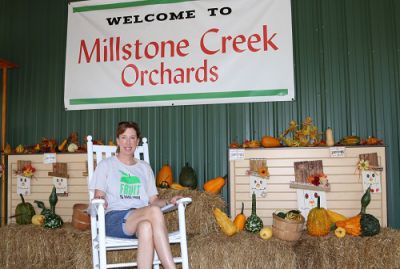
Beverly Mooney | Millstone Creek Orchard
[Perma Link]Previous NextBeverly Mooney | Millstone Creek Orchard

Q: When did Millstone Creek Orchards first open, and what types of fruit do you have that people can pick on their own?
We opened up to the public in 2004, but my dad bought the property in the 1980s. We have apple orchards, grapes, blueberries, blackberries, peaches, pumpkins, and pecans.Q: Are you open year round?No, due to much of the fruit trees going dormant during the winter, we are open from March until mid-December.Q: Are there specific ages for the tours you do, and how many people do you serve each year?We see approximately 3,500 guests here a year and we do tours from kids starting in preschool, going through elementary, middle, and even some high schoolers. We don't limit our tours just to schools, though. We have church groups and senior citizens coming in, and we're even open to corporate groups. This is a great place for families and couples, friends, anyone really. It's really a wonderful way to get outside and breathe in the fresh air, get away from the everyday life, and enjoy being in nature.Q: Do you have a main goal in mind you'd especially like to teach kids when they come?We try to lead by example showing people about stewardship of the land. For some kids who come here, particularly from the bigger cities, it's actually the first time they've ever seen fruit grow in nature. I once asked a question to a group of kids, "Where do you think apples come from?" A kid said, "The grocery store!" He wasn't the only kid who didn't know! People who live in rural areas are more aware of these things because they see them, but that still doesn't mean they actually know about how farming works if it's not what their families do. When people get to pick their own fruit or apples, and we show them how the apple juice is made by demonstrations where they make their own juice, they get a whole new appreciation of where our food actually comes from.Q: What are some of the other things you have going?Aside from the classes and the orchards, we also have hayrides, storytelling times, special events; and we sell Christmas trees, and of course we have a store. We sell all things apple, of course - apple cider, jams, jellies, apple slushies - and local honey, hand-dipped ice cream, gift baskets, local pottery, aprons, tee shirts, books, and other unique gifts. At Easter, we have a scavenger hunt, and throughout the season we have other fun things like apple bobbing and pie eating contests.Q: Is there a favorite thing people like to indulge in other than eating fresh apples or berries?I'd have to say the apple donuts are pretty popular, especially when they're hot!Previous Next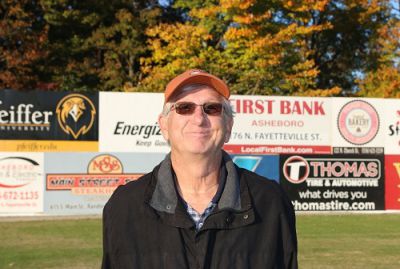
David Camp | Asheboro Copperheads Baseball
[Perma Link]Previous NextDavid Camp | Asheboro Copperheads Baseball

Q: Can you explain a bit about how the Asheboro Copperheads and the Coastal Plain Baseball teams work?
We are strictly a collegiate summer team which means that every single one of our players is a part of a college baseball team. There are 15 teams in the Coastal Plain League or CPL, and the teams are all from North Carolina, South Carolina, Georgia, and Virginia; and since we are a non-professional league all of our players are non-paid. The benefit to the players is, of course, they get an enormous amount of practice in their off-season from school, and we regularly have scouts come to the games to check out the players that have aspirations to go professional.Q: How many games do you play each season?We play even more games than they do in college on average. We play 28 home games and 28 away games for a total of 56 games - all in a 65 day period.Q: That's a lot of games and a lot of travel! How do these players afford to do this if they are unpaid?First of all, we have host families that put the kids up for the summer which is very helpful...and we've had some tremendous host families here in Asheboro! Some host families have even taken in multiple players at once, and many love it so much they host players year after year. Owning a baseball team is not cheap for any of our owners - brothers Steve, Doug, and Mike Pugh. They pay for all the maintenance of the field, team transportation, and a long list of other necessities, but it's something they all love.Q: How did you get into baseball?My dad was a baseball and basketball coach when I was a kid, and I used to be the bat boy for his teams. So I guess it's always been in my blood and a part of who I am. I never thought about being a major player myself, but I always knew I wanted to be a sports writer.Q: You have really made a name for yourself in the community as a sports writer, too. How did you get to the Copperheads?I was the sports editor for The Courier-Tribune in Asheboro for eleven years, sports editor of The Burlington Times-News, and worked for other daily and weekly papers. Eventually, because of my love of baseball and knowing Pat Brown, the previous owner of The Copperheads, I started off scoring the games for the team in 1999 when it first began and helping attract advertisers and host families. In 2008, I was hired as General Manager. It has been a great thrill for me to have been able to be a part of this team, for both me and my wife. In fact, she loves it so much that she's only missed about four or five games in the last eight years. It's been a privilege for us both.Q: What are some of your favorite things about The Copperheads and Asheboro in general?I take great pride in our world-class North Carolina Zoo, but really this team is my passion! Asheboro has always had a strong history in baseball going all the way back to the early 1900s. McCrary Park where we play was built in 1948, and we've had the American Legion games that were such a huge part of Asheboro in the 50s, 60s, and 70s through today. We've always had great community support, and we pride ourselves in being a part of baseball as a whole, too. We've hosted the American Legion's Southeast Regional Tournament each August for the past eight years. I'm proud that baseball has been at the forefront of our community.Q: For people that don't know that much about baseball, why should they come to the games?There are so many reasons to support our team! It's really a great place to spend time with the family. For the kids, in between innings, we always have fun games for them to participate in like the Dizzy Bat Race, the Tire Roll, Big Wheel Races, and other goofy games we play to keep it fun for them. We have a Veteran's Appreciation Night where we have fireworks in the first week of each season, along with the July 4th Fireworks, and a beer garden that's been popular with the adults. Coming to Copperheads games is even great for people in business. People come and meet other people in the community and many business deals have been made at this stadium! After all, life is about making memories, and I can't think of a better place to make great family fun-filled memories that will last a lifetime!Previous Next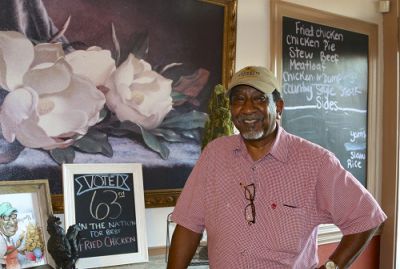
Don Simmons | Magnolia 23
[Perma Link]Previous NextDon Simmons | Magnolia 23

Q: You worked for Energizer Battery for 37 years. How did you manage to go from that to having an award-winning restaurant?
That's true, but after all those years at the plant I still retired early, and one thing led to another. I had two daughters that both went to the University of North Carolina at Chapel Hill, four years apart from one another. For eight years, I would go to the school and we would always be tailgating. Cooking and sharing food has always been a passion, so when passersby would come up to us while we were tailgating they would tell us how good everything smelled. I would always give them a taste. After a while the people I would feed bought me a cooker and they would even supply the food so all I would have to do is show up. People would always ask me when I was going to open a restaurant and finally, three months after I retired from Energizer I opened a catering business. The next thing you know we had the restaurant!Q: What are the favorite items of people who come in other than your delicious fried chicken and tasty catfish?Of course, the fried chicken is most popular along with the collards, Doris' cornbread, and Evelyn's famous mac and cheese.Q: You go to every single table and talk to your customers like they are family. Have you always done this?I want to make sure every single customer knows they are appreciated, and I want to make sure they are happy with their meals. If something is wrong I want to make sure I know about it so I can make it right. I try to talk to every customer like I would want them to talk to me, and word of mouth is very important to me. I want to keep people happy so they want to keep coming back. We are very lucky to have a loyal following.Q: You like to help our Veterans. How so?As a veteran myself, I have a special place in my heart to do what I can. Every three months we have the 108th Training Division of retired vets come to eat and they pay what they can. I do whatever I can in between. There are a lot of hungry people out there, so ever little bit helps.Q: You helped rescue an old cemetery in town. How did that come about?I also used to own a funeral service and one day I was out walking and I came across a grave that had been overgrown near a fence. I figured it was near the border of the cemetery until I looked further and realized that it was a black cemetery that had been neglected from the 1700s and through the Civil War. There were at least 250 graves that were wooded and needed attention, so about five or six people and I cleaned it up out of respect. Some of them did not even have headstones but we could tell they were graves marked with only rocks and no names. It's the least we could do to honor their lives.Q: What's the thing you are most proud of?When I was a kid I picked a lot of cotton in North Carolina not far from here, but I could never keep up with how fast others did it, and I always knew I wanted to do something else. Sixty years ago I was not event able to walk in the front door of most restaurants, and today I own one. That makes me feel pretty proud!Previous Next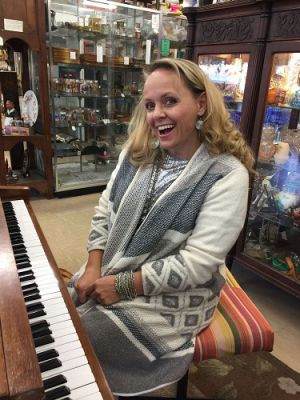
Donna Hughes | Singer/Songwriter
[Perma Link]Previous NextDonna Hughes | Singer/Songwriter

Q: Have you always wanted to be a singer-songwriter, and how long have you been doing it?
I started playing the piano at just three years old. In fact, I have a memory of going to the piano after hearing “You Light Up My Life,” and playing it on the piano. My mom was stunned. I didn’t read music at that time, I just played it by ear. I thought it was something everyone could do. Music runs in my family, but there was a point where they were giving up on me and my music because I just wanted to make my own. I wasn’t interested in doing other people’s music. Luckily, in time, things went my way and they realized music really was in my soul!
Q: What are some of the highlights of your career?
I’ve been very fortunate and most of my musical dreams have come true, and I’ve even surpassed up my own expectations of what I could do in music and where I could play. I’ve worked with some incredible people like bluegrass guitar legend Tony Rice, legendary banjo performer J.D. Crowe, and one of my songs was performed by Alison Krauss. I’ve played at BB Kings in New York City, with Ricky Skaggs at Dollywood, Marty Stuart at The Birchmere, and at Eddie’s Attic in Atlanta, and I’ve played four times at the Bluebird Café in Nashville. I feel pretty fortunate!
Q: How many songs have you written, and do you have any fears that you face being in the music business?
I’ve written approximately 500 songs. My biggest fear in writing music had always been that if I let people hear my songs, they will know what I’m thinking. This took some getting used to, but after doing it for a while, the ironic thing I found out was that many people think the exact same things I do. It’s actually liberating now. When I put my words on paper and others can relate, it’s a wonderful thing because they realize they are not alone in their thinking either.
Q: How do you describe your music to others? Is there a specific genre you play?
I am inspired by country and bluegrass music, but I play music from the heart so there are other influences as well. Being a singer-songwriter, I’m also inspired by folk and many other types of music.
Q: What is your favorite kind of music to listen to and do you have a favorite artist?
There are way too many artists I like. Even to name my top ten would be hard. I like classical, jazz, country, and mountain music, and growing up I listened to alternative, as well. I would have to say the music that seems to strike me the most are undiscovered musicians. We have a lot of talent - even around here - and it just doesn’t seem right that they all don’t have record deals. It’s a funny business.
Q: Do you have a favorite song that you have personally written? If so, what is it that is so meaningful to you, and why?
I wrote a song called “I Want to Grow Old with You,” and this is the way I feel about Andy, my fiancé. It’s what I live for. Life is not about the material things; it’s about spending time with the ones you love.
Q: How did your animal activism and anti-chaining song come about?
I used to pass by this poor dog on my way to work every day, and he was always locked up by a short chain, even in the rain and snow. I felt so bad for the dog that my heart hurt, and I was in turmoil over it. I feared if I confronted the owner he may not understand, and it would be illegal for me to take the dog. So I wrote a song about it instead. One day I was asked if I could sing for a classroom full of kids and I had no idea what song to sing for them, so I sang “Dog on a 10-Foot Chain,” that I had written. At the end of the song, many of them were crying. I suffered over this too, but in the end, I realized they opened my eyes even more, and I felt I had to do something. So I published the song. I knew it was bigger than me, and that I was lucky enough to have a platform in order to make people think. If just a few people have learned a lesson from my song and end up treating their animals better because of it, then it was worth it. Now I’m taking it a bit further and have started a charity for people who can't afford to get fences for their dogs, so they don’t have to chain them. It’s called Flying Hound Fences and anyone can donate to the cause and can make a difference.
Q: You’re also a real estate broker in addition to being a successful singer-songwriter. What made you decide to do that?
My dad was a real estate broker and an auctioneer and he wanted me to have a good life. He always told me he wanted me to be a school teacher or a real estate broker so I could support myself. I tried being a school teacher, and I taught gymnastics which I liked, but in the end, I felt more drawn to do real estate to augment my singing career. I really like selling real estate too because every day it’s a different scenario and I never get bored. I enjoy working with people and learning about their stories.
Q: Have you always lived in Randolph County, and what are some of the things you like about it here?
Yes, I’m part of my family's sixth-generation here in Randolph County. We go back to before the Civil War. I have lived in the same square mile all my life and I love it here. I feel such pride hanging onto the property that my family has worked so hard to keep. I love the sense of familiarity and the sense of community here. The people are so nice and caring, and I love the Southern hospitality and deep sense of home. I appreciate our historic sites. I think it’s amazing that we can still find Indian arrowheads in the woods. I love that there is still undisturbed land here with pretty wilderness and beautiful wildlife. This is definitely home for me...I’m not ever leaving!
Previous Next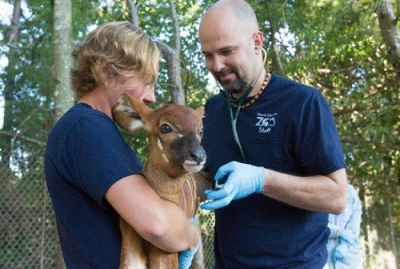
Dr. Jb Minter | Chief Veterinarian, North Carolina Zoo
[Perma Link]Previous NextDr. Jb Minter | Chief Veterinarian, North Carolina Zoo

Q: What is your position at the North Carolina Zoo?
I'm the Chief Veterinarian and Director of the Hanes Veterinary Medical Center.
Q: How many years of training have you had in order to be a veterinarian at your level, and where did you go to school?
Between undergraduate school, veterinary school, and doing the necessary residencies and training, about 14 years of training and school combined after high school. I earned my undergraduate degree in animal science at Virginia Tech; my master's degree in wildlife biology from Utah State University; and graduated from North Carolina State University - College of Veterinary Medicine. I did an internship in large animal medicine and surgery at the University of Illinois before moving to Florida to work in a small animal practice. Then I came back to North Carolina to complete my residency in zoological medicine and got my board certification in zoological medicine too. Now here I am now fortunate enough to be putting all of this education to good use.
Q: Do you have a favorite animal, and what is something interesting about that animal?
The Southern White Rhinos are my favorite animals. They are incredibly smart animals with a lot of personality and they love to be touched and scratched. The white rhinos have two horns rather than just one. They are highly sought after animals which sadly makes them endangered. I'm very interested in protecting them. They are incredibly fast animals that can actually run 30 miles per hour in short bursts. The males can weigh well over 4,000 pounds, but the females weigh considerably less. A lot of people are aware that rhinos like to take mud baths, but most don't realize why. The mud plays two important roles: it acts as a natural insect repellant, and as a great sunscreen. Yes, even rhinos can get sunburned.
Q: Have you ever been to Africa to see animals in the wild?
Yes, I've been to Africa and I plan to go back. In fact, the North Carolina Zoo has an elephant tracking program in Cameroon, Africa. Tracking the elephants helps in regards to conservation. By collecting data on their populations it helps the government to know where to build and develop, and where the important habitats need to remain to help them thrive. We have education programs for the local people to learn how to protect them, too. We also have programs to help protect threatened gorillas in Nigeria and Cameroon, as well as other conservation programs around the world from protecting frogs in South America to protecting biodiversity in North and South Carolina.
Q: What are your main hopes for people when they come to the North Carolina Zoo?
Anytime people come to the zoo they are helping our conservation efforts locally and globally just by walking in the front door. When people are able to see these great animals in person, it makes them more curious about how they live. We have information all over the zoo and we have programs for people to get involved into should they want to help more.
Q: What is the key takeaway to being a veterinarian at the North Carolina Zoo, and is there any procedure that you have done that made you feel particularly proud?
My main job is to keep the animals healthy and the best way to do that is through preventative care to keep any kind of illness from spreading. We take care of animals here of all sizes from the very tiny poison dart frog to elephants that weigh over 12,000 pounds. I would have to say that one of the most exciting surgeries I've probably done was a c-section on a gorilla. She was having problems in the birthing process and we were able to save the infant gorilla and the mother, so that was definitely one of the more satisfying feelings I've had.
Q: What are some of the strangest things you've had to do in order to help an animal?
Many of the animals are really smart and when we have to collect them to give medication, for instance, we sometimes have to take drastic measures. Some of the chimps recognize me even if I have a mask on, so we've been known to put on some pretty elaborate outfits including pretending to be a bush or whatnot, so that's always a challenge.
Q: What advice can you give people about owning a pet themselves?
Probably the most important thing someone can do is before they actually acquire a pet, is research that pet. A lot of people are surprised to find out that when their pet gets sick they may have to travel hundreds of miles to get to the nearest veterinarian. When you have a typical house cat or a common dog it's not that hard to find a vet, but if you happen to have a tropical bird, snake, or rare lizard, it may be substantially harder to get them care. Also, the costs to take care of animals may be a lot more money than people anticipate, so it's really important to do your research first before you own the animal or pet. Many people get stuck being thousands of dollars in debt or have to travel really far just to get a specialist. Not doing your homework first, even for cats, dogs, and hamsters can bring unexpected problems, and it's better to know these things before you make the decision to be a pet owner. Some people get turtles not realizing that the turtles may outlive them, and in some cases may even outlive their kids, so that's something to also consider.
Q: What are some of your favorite things to do in the Randolph County area other than the zoo? Where do you tell others to go here?
Of course, I love the Zoo., but I also love to go hiking in the Uwharrie Forest nearby, which is great to have that so close. I really like downtown Asheboro for the restaurants there, and I think they've done a really good job at Four Saints Brewery. Having the friendliness of the people who grew up here, and the energy of new people to the area has worked out well and I love being here.
Previous Next
Gene King | Seagrove Pottery
[Perma Link]Previous NextGene King | Seagrove Pottery
Q: How is Seagrove Pottery different than the other shops in Seagrove?
We are different mostly in the fact that we feature the works of so many different potters, not just one or two.Q: How many potters do you have?We have the work of 50 local potters, and 10 regional potters; and even a few from out of the area.Q: Are you a potter yourself, or do you come from a family of Seagrove potters?No, I am not a potter, I am simply a lover of potters and pottery. My wife and my family have always loved pottery. In fact, when I was young I remember having our storage places and our attic filled with antique pottery that my family had collected. When people would come to visit us I remember them telling me to run and get our visitors a piece as a gift. I didn't really understand it at first but as the years passed I realized how much people cherished those pieces we gave them, and I grew to appreciate that gift of giving pottery myself.Q: How long has Seagrove Pottery gallery been here?My grandfather actually built the building and gifted it in the 1950s as a fire station. When the town built their new station in the 80s, we bought it back from them. So the building has come full circle in my family. Then in 1999, we opened the Seagrove Pottery Gallery.Q: Even though you have so many different potters, do you have any particular specialty, or is it a bit of everything? And what are your top sellers?Despite our many potters we actually do seem to mainly have utilitarian pieces of pottery that people use on a regular basis. As a result, our best selling pieces are soup bowls and coffee mugs. There are so many people that love to drink coffee, that they make easy gifts to give, and it's great to have nice things you use every day.Q: When is the best time to come to Seagrove?We've been really lucky to be right off of Interstate 73/74 so it's a great pit stop for people to make all year long. I would say January and February are the slowest times but every single month after that is pretty consistent and just builds as the holiday season approaches. We are so busy that we're only closed four days a year - News Years, Easter, Thanksgiving, and Christmas!Q: Are there any particular colors or trends that you've noticed over the years? Is that even noticeable?I would say that there are definite trends just as there are in fashion. Right now, for instance, owls are very popular and many people collect owl items. As far as color, the reds and golds are popular right now. In the past, other trends have been turtles, or cats, or different patterns. A few years ago it was all about greens and blues. Before that, it was earth tones and other patterns. Even though the pottery is traditional, the decorative aspects change just like trends in magazines. Dragonflies seem to always sell well, though!Q: When people ask you what else they should see while they are in the area, what do you typically recommend?People love to visit the Historic Pisgah Covered Bridge and of course the North Carolina Zoo, but I tell them it's really worth it to see the two Visitor Centers we have. They are great buildings and one even has a living roof with and beautiful natural landscape. Plus, you can learn so much about the area there. Two of my other favorite places are the North Carolina Aviation Museum and the Petty Museum.Previous Next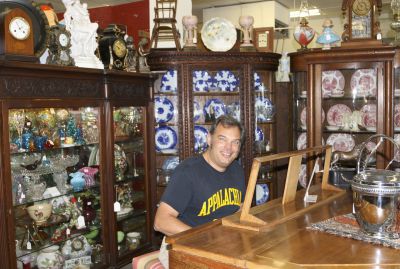
Jack Gorham | Collector's Antique Mall
[Perma Link]Previous NextJack Gorham | Collector's Antique Mall

Q: What is your history with Collector's Antique Mall?
I'm the manager here and I've been here for 23 years since it opened in 1993. Some of our dealers have been here for over 20 years, too. When we first opened we were only a small portion of the size we are now. We had about 14 dealers, and now we have approximately 85 with 35,000 square feet of space, so it's very large. It's been quite the journey growing not only here but watching downtown Asheboro's revitalization, too. When I started, the street only had a couple of businesses and now it's full of new places and full of life.Q: Does Collector's Antique Mall specialize in any one item, or what kinds of things can people expect to find?Because of our size, we really have something basically for everyone...but one can definitely expect fo find a large selection of furniture here from mid-century modern to period pieces. We also have pottery, glassware, dolls, records, coins, tons of old toys - probably more than most places - and a long list of other fun and peculiar items.Q: What's one of the more memorable or strange items you've seen sold here?One of the more funky things was probably a huge life-sized rhinoceros head made out of fiberglass, likely from a carnival. The fun thing is you never know what you'll find and that's why we have so many people coming back time and again over the years...we always have interesting things.Q: Do you collect anything yourself?I guess that goes without saying...I collect match boxes and Hot Wheels. I started collecting as a kid. In 1980, one of the first cars I got was a 1968 Camaro Hot Wheels car, and to this day it's still one of my favorites!Q: What are some of your favorite things about living in Randolph County?I feel so lucky to live and work where I do. Asheboro is such a great place now that it's actually becoming a destination for people from Florida to New York to regularly stop here. People obviously come to see the North Carolina Zoo, but they stay to shop downtown and to eat in our restaurants like The Table, Magnolia 23, Bia's Gourmet Hardware and The Fying Pig Food and Spirits - and more!Q: Where else do you like to go in Asheboro and why?We have a relatively new brewery called Four Saints, which is a great place for friends to gather, and they also have an open mic night. Even though I'm affectionately known as "the Junkman," I'm a musician and a singer-songwriter as well, so that's always a fun place for me to show off my new original songs and have a good time. The guys who started it are really great people, too! They've also helped bring new life to downtown. We really have a super sense of community here, and it's wonderful! Outside the Asheboro area, I highly recommend attending The Liberty Antiques Festival in nearby Liberty. It's a "must go to" event if you love antiques!Previous Next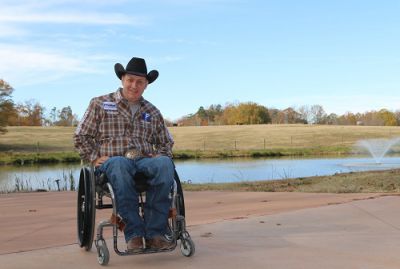
Jerome Davis | Davis Ranch
[Perma Link]Previous NextJerome Davis | Davis Ranch

Q: How does a person get involved in bull riding? Is it something you grew up around? How did you get your start?
I grew up in the Archdale and Trinity, and have always been around the farm. My grandparents had cattle and quarter horses, and I always had a love for horses. When I was a kid I rode bareback horses not far from here but always wanted to try riding a bull; and from the very first time I tried it at 11-years old, I was hooked. I rode Junior Rodeo at the high school level and went on from there.Q: How did you end up being a professional bull rider? Can you give a little history of how that happened?Because I did so well in high school I got a full ride scholarship to college in Odessa, Texas. During my freshman year in 1992, I became the world title holder for college. I knew it was something that I wanted to do all my life, so in 1993 I started my professional rodeo career. I made it all the way to the National Finals in Las Vegas and I was ranked fifth in the world standings that year. In 1995 I won the World Title. "He was the first person east of the Mississippi to win a World Championship! No one ever thought someone from North Carolina could win, but Jerome is too humble to talk about most of this stuff," )According to wife, Tiffany Davis, "He was the first person east of the Mississippi to win a World Championship! No one ever thought someone from North Carolina could win, but Jerome is too humble to talk about most of this stuff."Q: For someone who knows nothing at all about bull riding, what are some basic things to know? How long do you have to stay on the bull, and how does it work?Every rider must be able to stay on the bull for eight seconds, that's a must. One hand has to be on the bull rope, and one hand in the air to show control. There is a total possible score of 100 - the bull gets rated from one to 50, and the rider is also rated one to 50. They combine the points and whoever gets the highest score wins. It's based on the power of the bull, the techniques of how the rider dominates the bull, and how the rider controls the bull. That's putting it briefly!Q: You had a life-changing accident that left you in a wheelchair. Why you're still involved in bull fighting and event promotion of this sport?In 1998 I had nearly completed my final ride in competition when I was stomped by the bull. The doctors told me I would never walk again. It was obviously a huge blow, but it's my passion pure and simple. I just love it! I can't just sit around and feel sorry for myself, so now since I can't ride I help others fulfill their fantasies of bull riding. We have dozens of events every year at Davis Ranch. We have everything from rodeos, lessons, charity events, the Spring Free Rodeo, the Cowboy Stampede...and I do whatever I can to help promote the sport. We're proud to now have so many important bull riding events right here in Archdale. We have head-to-head barrel racing on barrel horses, food drives, and even great concerts - like Tracy Byrd, for example. I'm also proud to host the "Back in the Woods Again," hunting event for guys that are in wheelchairs too. Each year we have a deer hunt for the physically challenged with around 80 people participating. It's growing, and is a really special event!Q: What is the PBR all about?It's an international professional bull riding organization (Professional Bull Riders) that 20 bull riders and I started for bull riders only, so it's different than regular rodeo which has a multitude of events. I'm happy to see it grow so much and for it to become a multi-million dollar sport. It's actually one of the fastest growing sports now and growing all over the world, and I'm loving it! This sport is now broadcast on major television channels around the world.Q: What are your hopes and aspirations for the future?I'm just lucky to do what I do and to have my wife by my side. Each year it's our hope to add new events at Davis Ranch like the Chuck Wagon Cook-Offs, and more charity events to help more kids and those less fortunate than us. I want to keep up with the motivational speaking and I love seeing the sport of bull riding continue to grow, especially here in North Carolina!Previous Next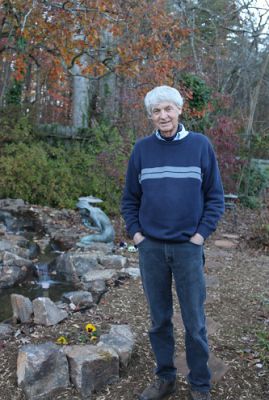
Jerry Bledsoe | New York Times Best Selling Author
[Perma Link]Previous NextJerry Bledsoe | New York Times Best Selling Author

Q: How did you become a writer, and was it something you always wanted to do?
Actually, I wanted to go to art school and I got talked into going into the Army because I was told they'd help pay for my art school and that it could be a good career path. As it turns out, the schooling I was looking into didn't really have the great art department I was hoping for. In 1960 I started working at the Post Newspaper on projects with the special forces near Fort Bragg. Then I finally got transferred to the art department of the paper when I was sent to Okinawa, Japan. I mostly worked on propaganda pieces and psychological warfare during the Vietnam War. I did headshots and drawings or illustrations, then I started doing posters of the generals. When I went to Tokyo I got to write for some propaganda magazines and I got to also write about topics I found interesting. That's when I decided I really wanted to write for a living.
Q: How did your career progress from there?As soon as President Kennedy was killed I had an overwhelming desire to go to Dallas and to write about the funeral, even though I had no outlet for my story. I sat on the grass where Oswald had just been and I had an innate need to become a reporter. When I went back home to North Carolina I met a WWII veteran that related to me from the Kannapolis Independent where I worked for a while. I also worked for the Charlotte Observer. In time I was a freelance editor and I worked in High Point for a paper and as a columnist in Greensboro. I wrote about subjects from the Civil Rights Movement to the KKK and black Muslims in Alabama and so on. I also wrote for Esquire Magazine. I traveled all over for stories from the jungles of South America to small towns in the U.S.Q: You wrote a book called 'Bitter Blood' that was the New York Tims Best Sellers List for many weeks, which is exceptional. How did that come about?I worked for the paper's crime list in Greensboro. In 1985 I did a big series of stories on this strange crime for eight days straight and later I turned it into a book, which was also made into a made-for-TV movie. That book is still a great seller which I'm happy about. Three of my other stories have also been adapted to film.Q: What is your favorite subject to write about?I like writing about ordinary folks I've met in the Carolinas. I enjoy getting to know people and getting them to open up to me. Sometimes it's a real challenge but I love it. It's exciting! I also like writing humor.Q: How many books have you written, and what was your first book?I've written more than 20 books, but I've edited and helped many people get their books done, too. The first book I wrote was 'The World's Number One, Flat-out, All-Time Great Stock Car Racing,' in 1975.Q: How many hours a day do you write, and do you have any favorite authors of your own?It depends on the day, but I typically write for many hours at a time once I get started. As far as authors I admire, there are so many! There never seems to be enough hours in the day to write or read all of the books I'm interested in. I'm a big Mark Twain fan. I like John Steinbeck, Truman Capote, Tom Wolfe, Thomas Wolfe, Reynolds Price...really there's just too many to think of. North Carolina is just crawling with great writers, too. It's a real hub of creativity here.Q: Do you have any favorite people that you have interviewed while you were a reporter or any interviews that stand out in particular?I wrote for The Plantation Supper Club in Greensboro and I interviewed so many people. It was always exciting because I never knew who I'd meet next, so I was never bored. I have some funny stories about Jerry Lee Lewis, and I got to know John Glenn really well, who was one of the original "Mercury Seven" astronauts. One story you may enjoy was when I was supposed to interview the band The Monkees, but they were too busy to talk to me. So I ended up talking to the guy that was the opening act for them who most people had never heard of yet. As it turned out, it was Jimi Hendrix! At first, he seemed disinterested in talking to me too, but when I brought up the fact I was also in the Army, I got his attention. Once I got him to laugh I knew we could have a good interview. We began talking, but he had to go on stage to begin his performance. He sang his heart out and put on a show like no one had ever seen before in Greensboro and at the end of the show, he smashed his guitar into a hundred pieces. It was a show stopper. When he walked off the stage the first thing he said to me was "I'd like to see those little Monkees top that!" He had on a pair of velvet pants and they were all ripped at the knees and I asked him if that had ever happened before and he said, "every damn time!" I'd have to say that one stands out, but I have dozens of stories...I couldn't pick a favorite.Q: Do you have any hobbies other than writing?I still love art. I love collecting art, and I love North Carolina pottery so I collect that, too. I love my rescue dogs and cats, and of course, I love reading.Q: What's your favorite thing about Randolph County?I've lived in this same house with my wife for 45 years. My wife and I always wanted stability for our son, Eric, and once we got here in Randolph County we knew it would be home. We live in a beautiful spot, and I've always known this is the place where I'm supposed to be. I've never looked back, I love it here. There's a lot of creative energy here and it's beautiful and close to everything we need. What more could I ask for?Previous Next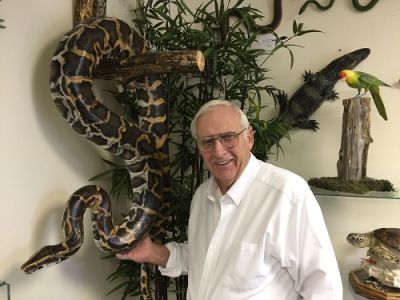
Joe Morgan | Morgan Reptile Replicas
[Perma Link]Previous NextJoe Morgan | Morgan Reptile Replicas

Q: How long have you been an artist and what got you into art?
I’ve been drawing since I was at least twelve years old but at the age of sixteen, I started taking art lessons on the weekends. I learned how to work with pastels and how to do oil paints. I would do landscapes and whatnot, but for what I am doing now, I am really self-taught. I learned through trial and error and years of experience.
Q: What got you so interested in making reptile reproductions?
I was a park ranger for more than 30 years and I really enjoyed being in the wilderness. We had some nature programs and in order to teach the kids about snakes, we would often taxidermy the snakes that we had found dead in the woods. I did this for a while but they don’t last forever this way and I wanted something more permanent. So I started making models of the snakes and other creatures from the real specimens. None of what I do now is taxidermy, they are all models from molds that I make or woodcarvings.
Q: How did it progress into what you are doing now?
I thought I was going to retire long ago after being a park ranger in Greensboro, but I enjoyed doing this, and I like snakes, so I just kept doing it. I’ve had the shop about seven years, but I first started selling the replicas in 1989. I have models of snakes, lizards, frogs, crabs, salamanders, birds, fish and various other amphibians. We have over 270 reptiles and amphibians to choose from and I’m always looking for new specimens to add to the collection. At first, I sold them in an unfinished form but I have developed an intricate process over the years that actually allows the reptiles to look like they are still alive. Having them look so realistic seems to be what people want the most, but you can still get them unfinished.
Q: How do you sell them, and who buys them?
Our shop in Liberty, called Liberty Artisan & Craft Guild Gallery, has a room where Morgan Reptile Replicas are on display. The gallery has become an attraction to the area, but some people come in just for curiosity and end up buying things they never dreamed of. A lot of people love snakes and such but may not want a real one. Most of my clients come from my website. I've sold them to people all over the U. S. and to people in other countries, too. A lot of people come in from news and magazine articles that have been written about my replicas, and they’ve been featured on television several times, too. I make them for nature centers, military bases, nature and science museums, and even for movie sets. I do custom orders as well.
Q: What other kinds of things do you sell in your shop?
We have a variety of different things for sale including books on the area, honey and bee-related items, stones and semi-precious rocks, art, handmade jewelry, and an array of gifts and crafts. We even have a bed and breakfast next door that's a quaint place for people to stay for up to a week at a time. We’ve made friends with people from all over the world by offering this.
Previous Next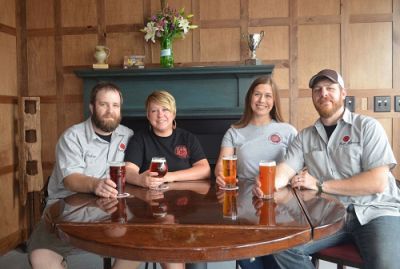
Joel McClosky | Four Saints Brewing Company
[Perma Link]Previous NextJoel McClosky | Four Saints Brewing Company

Q: You started a new brewing company in downtown Asheboro that people seem to love, and have a unique story of how you raised the funds to start it. Can you explain?
Yes, it’s true. We started a Kick Starter Campaign to help raise money for the brewery, but we also wanted to gauge what kind of interested there was in Asheboro, which less than 10 years ago was a dry town. We were thrilled that 75% of the money we raised was from locals and we reached our goal. Of course, we had our own personal capital to invest, plus we had investors and an SBA loan in addition to the Kick Starter funds. It took a lot of money to secure our leases, licensing fees, products, and marketing, but it all worked out and we’ve never looked back.
Q: How did you come up with the name Four Saints Brewing Company?
My partner, Andrew Deming, and I were having a conversation in his garage and our friend Pete was there, too. We were doing some research and Pete found out that there were four patron saints of brewing. We double and tripled checked to see if anyone else had a name involving these four saints and could not find anyone who even had a name close to what we wanted. The rest is history. Four Saints Brewing Company was born.
Q: What are your and your partner's backgrounds?
Andrew was the master brewer of home beers but neither one of us had a background in doing this professionally. At the time we met, I was a school teacher who worked with Andrew’s wife, and he was in retail management at Lowe’s Hardware. We both liked beer and thought it could be a good idea for the town, and luckily we were right. We love what we do!
Q: For those who know nothing about how to make beer, can you explain the process?
There are four main ingredients in making beer. The first is malts, which include barley, wheat, and other grains. You mix the malts, crush them up, and add water for it to become a mash. The mash will steep for about an hour, kind of like a tea bag, and it will produce flavor, color, aroma, and fermentable sugars. Once this is done, it becomes wort. Then you boil the wort to reduce it down and add hops, which gives it a certain bitterness, and it acts as a preservative. You boil that for about an hour then the fermentation process begins and you add the fourth ingredient, which is yeast. Without the yeast, there would be no alcohol. The beer takes about three to four weeks to ferment. Then we add carbon dioxide to carbonate it, put it in kegs, and serve it up!
Q: Do you serve food, and do you have any special events or activities at Four Saints Brewing Company you’d like people to know about?
We do not have a kitchen, but we serve some prepackaged local food. We also have a couple restaurants that deliver food here including Bia’s Gourmet Hardware and Mike’s Chicago Dog, plus pizza delivery. Some people even bring in their own picnic type food. As far as events we do a lot of specialty nights to keep things interesting. Every Wednesday we have a "drink and draw" with an artist, and we brew a small batch of specialty beer, about five gallons. Once it’s gone, that’s it. On Thursday's, we have Team Trivia and Theme Trivia, like Star Wars for instance, and that’s always fun. Every Saturday night we have live music. Every first Friday we have an open mic night, and on the second Sunday of the month, we have a pet adoption event since we are dog-friendly.
Q: What is the Four Saints Art Wall Project?
Every few months we feature a new artist, whether it’s a mural, portrait, or some other type of artist. Mainly we just want to support the local arts. We have receptions every few months and we love having new art and new energy here.
Q: What do you love about living in Randolph County and when people ask for recommendations of what to do here what do you tell them?
This is a really fantastic community. The people here really pull together whenever needed. People know you by name and we have each other’s backs. I believe this community is moving in a forward direction and it is really great to see. Some of the places I love myself are the same places that I send others. They include the North Carolina Aviation Museum, Petty Museum, and the Seagrove Pottery community. Places I love to eat are Bia’s Gourmet Hardware, Flying Pig, The Table Farmhouse Bakery...gosh, there’s so many more, too! My daughter especially loves di’lishi Frozen Yogurt Bar...they are great people and great yogurt!
Previous Next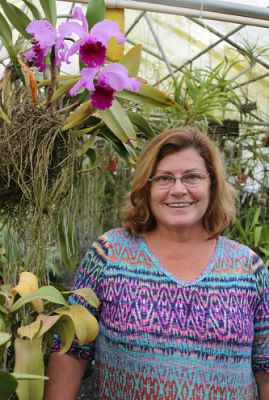
Linda Thorne | Seagrove Orchids
[Perma Link]Previous NextLinda Thorne | Seagrove Orchids

Q: I understand you are known as "The Orchid Lady." How did you get into growing orchids?
That's true, some people only know me by that name! I got started many years ago by accident. I had an orchid and it was so beautiful, but after the first flowers died it did not bloom again for years. I was determined to have another bloom and I found out that if it has more sunlight it may bloom again, and it did. I was so proud, then one orchid became two, and two became ten...I just couldn't stop. I was hooked!
Q: How big is your greenhouse and many different types of orchids do you have?
We have 37-acres and two greenhouses with approximately 5,400 square feet, and I proudly have over 200 different types of orchids available.
Q: How long does the average plant flower usually last?
It depends on if they're taken care of properly, but many last five to six months, although some of the larger ones like the purple Independence Day orchid may last about eight to 12 weeks. The plants themselves will last many years, and the flowers last much longer than buying bouquets of flowers that barely last a week. They can bring you so much happiness.
Q: Is this your full-time job or do you do anything else?
I am currently in nursing school because just like in my orchid business, I love science and people. I'm a nurturer!
Q: What is your favorite part of being in Seagrove?
I love the creative nature in the area the most! I could certainly do more business financially by being in a larger more suburban area, but it's affordable, friendly, and beautiful here.
Q: I see you have a lot of pottery, are you a potter too?
No, but that is also one of the good things about the area. I support as many potters as I can and they support me, too. I'm lucky that way!
Previous Next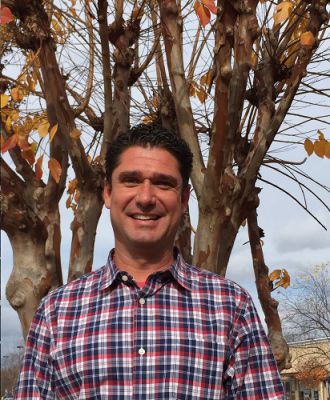
Luke Hollingsworth | Holly Ridge Golf Links
[Perma Link]Previous NextLuke Hollingsworth | Holly Ridge Golf Links

Q: Explain a little bit about the Holly Ridge Golf Links for those who know nothing about it.
It's an 18-hole golf course designed by Jim Bivins that was opened in 1994. It's located in Archdale in a great location, and it boasts some of the best conditions when it comes to public golf courses in the Piedmont Triad. We pride ourselves on that!
Q: Does it have any amenities other than golf even though it's a public course?
Yes, we have a full kitchen, bar, and grill which is unique for a public course. We serve beer and wine along with a full liquor bar, and our food is great, too. We have a pro shop and we offer golf lessons. Holly Ridge is also a wonderful place to hold events including weddings, reunions, and corporate outings. We're open on Thursday, Friday, and Saturday nights for dinner. Lots of people come to eat after hearing about us and are pleasantly surprised to find out we're open to the public. It's not a pretentious place here...we're more like family and everyone is welcome!
Q: What are some of the most popular food items that people order on your menu?
We serve a 14-ounce rib eye steak, and people really seem to get excited about our pork chops and quesadillas. We hand cut all of our meat, and we make everything fresh and on site from our great salsa to a tasty chicken salad. Nothing is processed. People may come for the golf, but they stay for the food, and lucky for us some people come just to dine and hang out!
Q: What makes the Holly Ridge Golf Links so special?
Repeat visitors. We feel very fortunate to have so many recurring guests. We are a first-class public facility and we look forward to seeing our guests. We try to maintain a cozy atmosphere for people. Our staff knows most people by name and they love their jobs, so we're lucky in that. We have a lot of regulars but we always welcome new people, too. We make it a point to make people feel at home here. One of my other favorite things is our huge wrap-around porch. It's a nice place to hang out and enjoy a gorgeous sunset overlooking our quaint pond and watching the golfers come in from the 18th hole.
Q: Do you have any annual events at Holly Ridge?
We have a charity event that that is held in August called the Holly Ridge Charity Classic and I'm honored to say that we've raised more than $150,000 for Hospice of Randolph County. That's important to me! We also have an annual Customer Appreciation Event at Christmas where we supply all of the food and there is no charge to eat. We have music and a DJ and it's a real party for everyone.
Q: You must really love Randolph County since you grew up here and are still here today. What keeps you here?
This land is special to me. It used to be our family dairy farm, and my dad and two other guys built this course. For me, the people in Randolph County have always stood out to me as being inclusive and warm, and I feel a sense of belonging here. Home to me is where I grew up and I stay because I love my life here and I love what I do.
Q: What other places in Randolph County do you recommend others to visit?
Naturally, people come here to visit the North Carolin Zoo and to see the potters in Seagrove, but at this end of the county, we have some family-oriented attractions, as well, like Kersey Valley Attractions in Archdale. The have zip line adventures, a famous corn maze, and Spooky Woods at Halloween. People come from all over for that. They have laser tag and hay rides and do a really great job there. We also have a small town called Liberty and for those who like to take a drive in the country and go to a place with that authentic small town feel, it's a nice place to visit. The people here are just very generous and welcoming.
Previous Next
Mac Whatley | Randolph County Historian
[Perma Link]Previous NextMac Whatley | Randolph County Historian
Q: It's hard to categorize your title because you've done so many things, but you're known as the unofficial or official, depending on who you talk to, local Randolph County Historian. Can you tell me a bit about your background and schooling and how you became a historian?
I grew up in Randolph County and went to Asheboro High School. My parents grew up close by too went to Seagrove High School. I received my undergraduate degree from Harvard University where I specialized in architectural history. I got my MA from UNC Chapel Hill in library science, and a JD degree from NC Central University in Durham. I've had a strong interest in the history of our local area stemming from some of the jobs I've taken on and my background. I practiced law locally for almost 30 years and yet when this position working in the Randolph Room at the Asheboro/Randolph Public Library became available, I knew it would be a good fit. So here I am!
Q: Weren't you the mayor of Franklinville?
Yes, I still live in Franklinville and I was elected mayor there three times starting in 1983 through 1987, then again from 1991 to 2006. I serve on their Board of Commissioners now.
Q: So can you tell me a little bit about the Deep River Trail and the Deep River Rail Trail in Franklinville? Are they the same thing?
The Deep River Rail Trail follows the right of way of the Cape Fear and Yadkin Valley or "Atlantic and Yadkin" Railway, which operated from 1889 to 1984. The piece of the trail now open is less than a mile, but as we get funding to build bridges to replace the missing trestles, it will run for three to four miles from Cedar Falls through Franklinville to Ramseur. The ultimate plan is to connect it with the Deep River Trail that runs along the Deep River all the way around the lake from High Point. The entire Deep River State Trail corridor is mainly a paddle trail now for canoes and kayaks that run through Guilford, Randolph, Chatham, Moore, and Lee Counties. The goal is to complete a 15 mile stretch of it through Randolph County for hikers, walkers, joggers, and bikers, which will be great for the whole area.
The trail was used by Native Americans and was a very important part of our local history in regards to transporting textiles going all the way through the Revolutionary War.
Q: What is the Faith Rock Historical Landmark?
Faith Rock is a Revolutionary War landmark that relates to the story of Colonel David Fanning, the Tory (pro-British) leader who carried on a guerilla war in central North Carolina, even after Cornwallis surrendered in Yorktown. Fanning's headquarters was a Cox's Mill in the southeast part of the county, but he led attacks on government forces as far away as Fayetteville and Hillsborough. Like most guerrilla wars, there was a lot of random violence - murders, house and barn burnings, torture, and Fanning's reputation was merciless. In 1782, he captured a Whig (pro-American) leader named Andrew Hunter and set him up for execution. Unexpectedly Hunter grabbed Fanning's horse, Bay Doe, and rode off on her. Fanning and men chased them through the woods toward what is now Franklinville, thinking Hunter would be trapped on the cliff above Deep River, but Hunter rode Bay Doe down this big treeless rock, about 75 feet above the river, jumped the horse into the water, and swam away escaping. Fanning couldn't follow that kind of suicidal leap, a leap of faith. Thus people started calling it Faith Rock.
Q: Can you summarize the legend of Naomi Wise that made this are so famous in songs from Bob Dylan to Doc Watson?
Naomi Wise was a servant girl living with a Quaker family in the New Salem community of northern Randolph County. She was romanced by Jonathan Lewis, a local Constable or deputy sheriff, and wanted him to marry her. Instead, he was accused of drowning her in Deep River just east of Randleman, at what's now called Naomi Falls. Lewis was arrested and held in jail in Asheboro for about eight months when he mysteriously escaped. Years later he was tracked down out West and brought back to Randolph County for trial, where he was never convicted of the murder. But the bare facts have taken a back seat to the romance of the traditional folk ballad written about the murder, and a romantic and very inaccurate short story written about it by Professor Braxton Craven of Trinity College, now Duke University. Both the story and the ballad make Naomi out to be a poor innocent virgin taken advantage of by her black-hearted lover, and it makes for a catchy song...but the truth is somewhere in the middle.
Q: Why is preserving local history so important to you?
Local history is personal history. It's who you are. Life is all about decisions made long ago before we even existed that we have to live with today. Preserving history teaches us valuable lessons. Without preserving local history we tend to get historic amnesia and history turns to folklore without proof of the real truth. On a community level, it also teaches us who we are - the past gives insight into our present behaviors, from the very personal, to the national levels.
Q: You've been published many times but you've also written three books about the area here. What are the names of your books and where can we find them? Also, can people come see you at the Randolph Library with their questions?
Randolph County (Images of America) was published in 2010. NC: Randolph County: A Pictorial History was published in 2004. The Architectural History of Randolph County was published in 1985. I can be found most Monday's through Friday's in the Randolph Room specifically to help people with questions they may have about the area and our history. The Randolph Room is located inside Randolph County Public Library located near the courthouse on Worth Street in downtown Asheboro.
Q: What are a couple of your favorite things about Franklinville?
Franklinville was the first mill village to become an incorporated town, in 1846. It is the site of one of the oldest cotton mills in North Carolina, and so it's one of the places where the Industrial Revolution first took root here. It was founded by Elisha Coffin, a member of a Quaker group from the island of Nantucket who moved here in the 1770s and was the leader of the pro-industry, anti-slavery activists of the 19th century. Franklinville was named after Jesse Franklin, a governor, and congressman who led the fight to keep slavery out of Ohio and Indiana. Elisha Coffin and the other mill owners looked at mill work as a social welfare project for widows and orphans, letting them earn a living when there was no social welfare safety net. He built the house I live in now and helped escaped slaves move through Randolph County on the Underground Railroad. There aren't many places in Randolph County with as rich a history as Franklinville.
Previous Next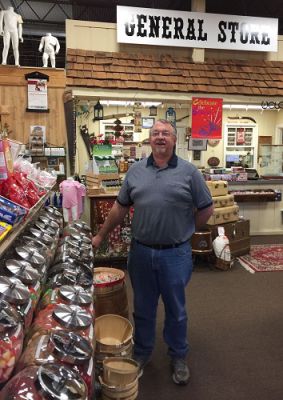
Mark Rumley | Bush Hill Trading Post
[Perma Link]Previous NextMark Rumley | Bush Hill Trading Post

Q: What is Bush Hill Trading Post, and your goals for it?
I love to bring back old memories for people, and I love creating new ones, too. That's it, pure and simple.
Q: You offer more than antiques and general store items. What other items do you sell?
In addition to selling vintage items and collectibles, we also have shabby chic items. Plus we offer Nanny Bea’s Ice Cream Parlor and gourmet cotton candy, Red Bird Candy, Blenheim Ginger Ale, Mrs. Hane’s Moravian Cookies, Jody’s Gourmet Popcorn, and also Howard’s Refinishing products.
Q: Is there something special about Red Bird candies?
Yes, they are an example of a taste of simple old-fashioned goodness and a regional favorite that is locally made!
Q: How many vendors do you have and is there a particular theme of things that you try to sell at the store?
We have approximately 40 vendors and each one sells slightly different things. You just have to come in and see for yourself.
Q: What was your background before you opened Bush Hill Trading Post?
I was in the manufacturing industry and the retail uniform business. I'm also an auctioneer which, of course, has helped in the business I’m in now.
Q: Are you a collector yourself of antiques or of anything in particular? If so, what do you collect?
It's probably funny to most, but I’m not really a collector myself. I just have a deep appreciation for antique, vintage, and eclectic items.
Q: What are some of the things you like most about Randolph County?
I love that we are centrally located in the heart of North Carolina, and I am grateful for Randolph County’s ability to actively help in the promotion of small businesses. You just don’t get that everywhere!
Previous Next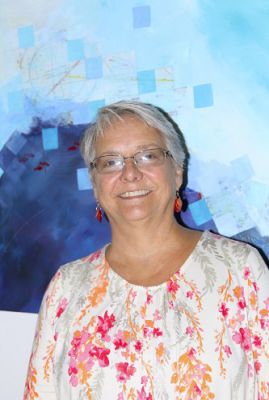
Melissa Walker | Carolina Bronze Sculpture
[Perma Link]Previous NextMelissa Walker | Carolina Bronze Sculpture

Q: You have been teaching art for many years. What is your background and what do you love about teaching?
I've been doing art all my life. I went to college at East Carolina University and majored in art. My husband, Ed who is also an artist, also went to school at ECU. Afterward, I went to graduate school at the University of North Dakota in Grand Forks. I'm not teaching anymore, but I taught mainly high school art at Randleman High School. What I love about teaching high school students is you can talk to them on an adult level and they are much smarter than some people give them credit for. If you show interest in them and they feel respected, they can do some really serious art. I love seeing my former students, and I love knowing that I have made a difference in some of their lives. It's really great.
Q: What type of painting do you do and do you have any preferences in color or style?
I'm mostly an abstract expressionist painter. That type of work is my favorite because of its structure and spontaneity. Having said that, there is ironically a lot of planning that goes into a painting just to make it appear random. It's actually more difficult for me to do this type of work than it is to do realism. I like to use nautical maps in my abstract paintings and turn them into what looks like a landscape with a birds-eye view. As for colors, I love greens and blues, but I use the full spectrum of colors in my work.
Q: What do you at Carolina Bronze, and what do you like about it?
Carolina Bronze Sculpture is a fine arts bronze foundry. We specialize in bronze casting, fabrication, and digital enlarging. It's one of the premier foundries in the country. I love sculpture and I love art but here as opposed to teaching, I love to come up with my own plan of action. There are no step-by-step instructions like there are in teaching. I can be creative in my own way and like Ed has always said, "just do it."
Q: What are some of the other projects you are working on that excite you?
We are in the midst of opening a sculpture park here with a pond and a nice walking trail that will showcase many of North Carolina's wonderful sculptors. We will have some renowned artists and we look forward to this park growing over the years. We also always look forward to the Tri-State Sculptures Conference each year. It's a conference that is designed to meet the needs of sculptors and educators working in a variety of 3-D media including metal, glass, stone, fibers, mixed media and of course clay. It's a wonderful way for artists and people to network and learn.
Q: What do you like most about Seagrove?
I love being in the center of the state. Our location makes it so easy to get to the mountains and the beach or even state to state. In addition to Ed & I being artists ourselves, we are also collectors of pottery and there's no better place to be for that than right here!
Previous Next
Phil Morgan | Phil Morgan Pottery
[Perma Link]Previous NextPhil Morgan | Phil Morgan Pottery
Q: What type of pottery do you create?
I create two main types of pottery - salt glazed and crystalline pottery.
Q: What is the salt glaze process?
The salt glaze process started about 250 years ago in Germany when a potter used some wood that was from a fish factory. The short version of the story is the potter needed some wood and a person at the fish factory offered him the wood barrels that they no longer needed at the factory. Because the fish was brined in salt when the potter fired up his kiln the pieces came out with a special texture to them kind of like an orange peel. He liked the effect so he kept doing it and later others followed his process. In the 1920s and 30s, this process was used a lot around here to make water jugs and moonshine jugs. Over time rather than needing to use the jugs for utilitarian purposes, people started collecting them for their artistic characteristics.
Q: What about the crystalline process, how is that different?
The salt glaze is made from stoneware and the crystalline is made from porcelain. The crystalline pottery first started around 600 AD as an oriental art form. It’s the art of making crystals in the glaze. You create a snowflake using zinc oxide in the glaze while it’s in the liquid form at around 2000 plus degrees. You blend the glaze to melt into the glass while the clay vitrifies.
Q: How did you become a potter? What’s your background?
I grew up about six miles from my shop in Seagrove. I was drafted after high school but luckily was sent to Korea rather than Vietnam in 1967. When I came back, I finished my business degree and put on a suit and tie to head back to work. After about six months I knew I wasn’t a suit and tie kind of guy. Back then there were trade schools or technical institutes to help people get into different professions. I was on my way to check out auto-body and gunsmith demonstrations and along the way, I walked by a pottery shop. Once I saw what they were doing I was immediately hooked. I loved everything about it and knew that was it for me.
Q: How is your process different than other potters that make pottery salt glazed and crystalline pottery, or is it the same?
I make all of my own porcelain and glazes by hand. I do not use store bought glazes and I don’t use technology to try to perfect my craft. I take pride in doing my art a specific way.
Q: What are you most proud of in your art?
In the 1980s, the Smithsonian bought several pieces of mine for their museum, and various North Carolina Governors have purchased my art to gift to five different presidents and prime ministers around the world. I’ve been written about hundreds of times in different newspapers and magazines. The thing I’m proudest about though is just the fact that I’m still here and that I’m doing my art the same way I've done it for 40 years. I’m proud that I still make all of my pieces the way I did way back then. A lot of other potters now depend on technology to create the crystals in their pottery, but I make mine old-fashioned way. I also pride myself on not selling "seconds" to anyone. I’m proud of my reputation and I’m happy there is very little aftermarket pieces of mine - that means a lot to me. I treasure my collectors whether they have two of 200 of my pieces.
Q: How do you feel about having so many potters in the area?
I think it’s great! We all work together and there’s really only one good place to come for pottery lovers and the variety that we have...and that's Seagrove!
Previous Next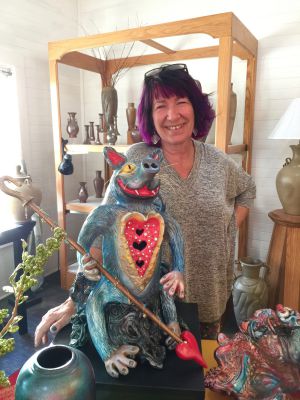
Regina Voncannon | Pottery Junction
[Perma Link]Previous NextRegina Voncannon | Pottery Junction

Q: When did you first start your pottery career and what is the brief history of your career?
I first started in 1986, but I didn't start selling to the public until 1989. Then in 1991 I was so immersed I began teaching ceramics and I taught for over 20 years until 2014. Now I have my own shop and it's really great. I'm now pursuing a whole new style of ceramics than I have in years past.
Q: What type of artist are you now?
I'm a very technical person. I love chemistry and balance and process, and that is why I loved teaching so much. I feel to really be good at pottery you need a solid background or training. Not to say there are not people that are just naturally gifted artists, but there are still basic principals to go by. For years I was doing traditional classical forms, with my own twist of course, but now I'm really exploring a whole new direction. I would say now I'm taking a futuristic twist with my pieces with a feminine touch. I do fluid forms but I like interrupting them with something unexpected.
Q: What else do you love about pottery?
I like making utilitarian pieces and giving them a decorative flair so each piece has a beauty of its own. These are pieces that you use all the time, but you still get the thrill of having something beautiful. The beauty of having pottery that is handmade is that not only do you have something extraordinary, you also have the personal connection of the person who made it, and a memory through each purchase.
Q: What makes you different as an artist? Do you think you have a different approach to attracting people to you as opposed to other potters since there are so many in the area?
There are a ton of great traditional potters here and a lot of what you may call traditional buyers of a certain age like about 40-60. I'd like to appeal to a younger crowd that thinks out of the box. I like making repurposed things with some recycled objects but not antiques. I like interesting pop, surrealism, modern and contemporary all spun together. I like quirky fantasy pieces, and I like it when light reflects nicely on pieces so I'm currently using a lot of metallics and I'm experimenting more and more.
Q: You're known for making some funky pieces. What about those?
I just finished one called Julietta. She's a pig, cat, monkey baby with more than one heart. I know that may be hard to visualize, so you'll just have to come for a visit, or find me online!
Q: You're also known as someone who changes her hair color frequently. Why does it always seems to be changing?
Funny you asked that! I just dyed it black and purple! That's just me.
Q: What do you love most about Seagrove?
I love that we have a strong community of like-minded creative people. I love driving through the farmlands and the rolling hills and seeing the animals. There is literally inspiration around every bend. I love the connection of Mother Earth here due to the open space. How anyone could not love it here would be beyond me?! It's a blessing to live in Randolph County!
Previous Next
Richard Petty | King of NASCAR
[Perma Link]Previous NextRichard Petty | King of NASCAR

Q: You're one of the top names in NASCAR, in fact, you're called "The King of NASCAR" for being a seven-time champion of NASCAR, but for those who really don't know anything about the sport, can you explain what NASCAR is?
Wow, that's a hard question, and one I don't usually get asked...I'll start with saying it's the second largest spectator sport in the United States. It stands for the National Association for Stock Car Auto Racing. It started out as strictly stock car racing but now it's all-out racing. In 1949, the first "strictly stock" race was held in Charlotte. Over the years it has grown in so many ways and it's a sport that is enjoyed by a wide variety of people all over the world.
Q: How did you first get involved in car racing?
My father, Lee Petty, was involved in racing and he was one of the pioneers of NASCAR and one of its first big stars. When I was 11 years old, I remember other kids going home after school to help out in the tobacco fields or work on their parents' dairy farms, and I would go home to help my dad with the cars. I loved it! Maybe if he was a farmer I would have been a farmer, too? Most of my family is now involved in racing, so it's truly a family affair.
Q: What should one expect to see when they come to the Petty Museum in Randleman?
We have lots of cars here - some that won Daytona and some that won other races. It's a family museum of memorabilia of cars and things from my father, my son Kyle Petty, grandkids, and cars of mine. The museum is dedicated to preserving the Petty NASCAR legacy for my whole family - not just me. We have vintage cars, a kids "pit stop", and historical information about racing. It also holds a collection of vintage guns and belt buckles. We have a trophy room and even dolls that my wife, Lynda, collected displayed in her memory. The museum is located right next door to the home I was born in, and on the other side, we have Petty's Garage.
Q: What do you do at Petty's Garage?
Petty's Garage is a high-performance speed shop that we opened in 2008. We specialize in all high-performance upgrades for your cars. We say if you can dream it, we can build it! If you want it souped up, lowered, jacked up, or decked out, we can do it. We also offer painting, custom interiors, superchargers, custom projects, restorations...whatever you're looking for. It doesn't matter if it's for daily use, car shows, or custom collections. We welcome everyone's ideas and we love answering questions. Our goal is to have customers for life.
Q: What's your charity all about, can you explain?
Yes, thanks! It's called Victory Junction Camp. We started this camp in honor of my grandson, Adam Petty, who was tragically killed in an auto accident in 1999 when he was only 19 years old. It started when Adam and Kyle visited Camp Boggy Creek in Florida. Adam was so inspired by it and he wanted to start a similar camp in North Carolina. He was often found in pediatric hospitals visiting kids with challenging medical conditions and he wanted to make a difference himself. Because of his dream we started the camp in his honor.
Victory Junction Camp serves kids with disabilities, physical limitations, and chronic medical conditions whether they are on dialysis or chemotherapy. The camp allows them to have normal childhood experiences. It's not only about fun, although they do have tons of games, talent shows, zip lines, and theater, but it's to challenge them so they can discover how resilient they really are and they discover what they are capable of doing. The camp was started as part of Paul Newman's Hole in the Wall Gang Camps. It takes tremendous amounts of money simply to keep it going, about $6 to 7 million dollars a year. At first, we thought we would only help kids in about a 250-mile radius from here so people could drive in. That's not how it's worked out though; we've flown kids and their families in from Nebraska, who could never afford to make it otherwise, and it keeps on growing. We've helped over 25,000 kids from all 50 states, and seven different countries now. We depend on donations and appreciate anyone who wants to help.
Q: Do you have other special things you'd like to talk about like events you hold at the museum?
We hold events throughout the year for kids of all ages, and host PettyFest on the first Saturday of Memorial Day weekend when the Coca Cola 600 is held. PettyFest celebrates our fans, especially our veterans, and gives us an opportunity bring in NASCAR people, as well as hold demonstrations. Each year at Christmas, we hold an event the kids love called, "Santa & The King," which is always a good time!
Rebecca Petty Moffitt: Dad also signs autographs and takes photos at all our events...that's really what he's known for and what draws people to him. He's always been accessible to his fans!
Q: What do you love about Randolph County?
There are so many things I love. I love the location because I can get to the mountains, the beach, Charlotte, Winston-Salem, South Carolina, and Virginia so easily. I love the mild weather here. It's very unusual to get a huge winter storm or even a hurricane because we're just perfectly situated. I feel safe here because I grew up here and I understand the people. I love it because it's home. I've been to many different places, but still I choose to live here. It's really my dream place to be, and that's why my wife named our house 'Reverie Place,' because she felt the same way about where we live.
Q: What do you want your legacy to be?
I can't control what others think of me. I got to where I am today with a whole lot of help from other people. I don't want to be put on a pedestal, that's not my thing. I did what I did out of survival and passion for what I do. I have a rule I go by that I call the 90/10 rule - 90% of what we do is reactive, and we do the best we can with the other 10%. I guess I'd say to people "do the best you can with what you've got." That's my motto.
Previous Next
Sid Luck | Luck's Ware
[Perma Link]Previous NextSid Luck | Luck's Ware
Q: It's pretty incredible to learn that you are a fifth generation potter. Is that true, and, if so, what do you know about your family from so long ago?
Yes, my great great grandfather, William Luck was doing pottery in this very area during the Civil War. My family was known to be farmers and potters, much like they still are today. Actually, some of my family members were also known to be Outliers and Deserters which was really dangerous. They would have to hide out in the Uwharrie Forest for lengths of time when the soldiers came. Back then it was a necessity to make pottery like jugs for water, and jars for containing food. The pottery was mostly utilitarian, and of course, most people around here were farmers too.
Q: Have you always been a potter?
Yes, I've always made pottery but I never thought to make a living doing only pottery as life had drastically changed and people no longer needed it. It became more of something they just like to have, use, and collect. So after serving in the military, and after college, I became a school teacher. I taught science and math, but mostly I taught chemistry for about 18 years. Finally, after I had taken care of my family the best I could, I decided I really wanted to pursue making pottery full-time. Many people never thought I could do it, including my father, but to everyone's surprise, I've been making pottery full-time for more than 25 years...after several years of doing it on a part-time basis before that.
Q: Is your family involved in pottery now?
My wife is a librarian, and I have two sons: Jason is a lawyer, but he also loves to do pottery, and my other son Matthew has carried on the family tradition of being a poultry farmer but is also a talented potter. That works with me. My 14-year-old granddaughter, Madison, also loves making pottery, so she is technically the seventh generation potter from my family.
Q: What's your favorite type of pottery to make?
I'm kind of a traditionalist. I love to make traditional functional pottery. I'm proud to carry on not only the tradition of my family but the tradition of the Seagrove area.
Q: What do you think about all the new potters who have come into the area since you were young, and how do you stand out?
I think it's great. We have a strong community here, and I'm not worried about copycats. I just love what I do. When I was younger I used to dig my own clay. Now most of us buy our clay locally, so we don't have to do the work. I do however think my background in chemistry has helped me stand out when it comes to mixing my own glazes. I've always made my own glaze, from metallic oxide, cobalt iron, and copper, and my stoneware jugs are somewhat widely known.
Q: Do you have any funny stories about doing pottery or stories that make you feel thankful or proud?
I suppose I have both. I'm very thankful and proud to be doing exactly what I'm doing now and feel very fortunate to be able to make a living as a potter. One funny story is that I once made dozens of plain small jugs for a class so they could use them to create face jugs. After they were all done, one boy in particular that rarely spoke due to autism began to study the faces for a very long period of time. When he was finally done he went up to his teacher and told her he thought she had some really nice jugs.
Previous Next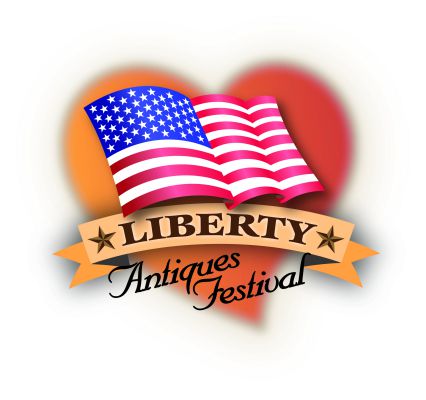
Vito Sico | Liberty Antiques Festival
[Perma Link]Previous NextVito Sico | Liberty Antiques Festival

Q: When is the Liberty Antiques Festival, and how long has it been around?
It started 25 years ago in 1991. We host it twice a year on the last Friday and Saturday of April and September.
Q: About how many vendors do you have, and what's the attendance like?
We have more than 375 dealers from all over the country. We literally have vendors that come in from Texas, Ohio, Florida, and all up and down the East Coast. About half are from North Carolina. Some have been coming twice a year for 12 to 14 years in a row now, so we must be doing something right. We open the gates from 8 am until 4 pm, and we usually have way over 1,000 people waiting in line when we open. We have shoppers that come from all over the the state and the country - about 10,000 of them over the each two-day period.
Q: It's really impressive to have so many dealers and such high attendance each time. What do you think makes it so special that people are willing to travel so far to attend?
It's not your typical antique show, and that's why I call it a festival. It's really fun! We have great food including Italian, Chinese, Greek, barbecue, and desserts, along with hot dogs and hamburgers. Because we always sell out our vendor spaces, we only take vendors that are nice - people that we like! We've all become friends and it's important that we are all happy people...life is too short to have grouchy people around you. People always talk about what a good time they had, and how they met new friends. That's why they keep coming back!
Q: Do you do the show on your own and how did it start?
I work with my wife, Mary Ellen, and our partner, Janet. Janet owns the land that the festival is on. The land used to be an old dairy farm and it has been in her family since the Civil War. I moved to the area about 40 years ago when my father-in-law moved to the area. The short story is that I walked into the grocery market one day to buy a gallon of milk, and I met a real estate agent. I said that I'd like a barn or a place to store all of my junk, and the next thing you know I was here.
Q: What's your background, and how did you get into antiques?
I went to art school, and I was in advertising first, but it all started with a yard sale I went to. It was popular to buy old furniture and paint it to make it look like it was old - even if it wasn't. So I bought a couple of night stand tables for about $5 each and I painted them green or blue and put some burnt umber stain over them to make them look aged. I would resell the pieces for twice what I paid. It was easy and I loved it. Immediately I was hooked so I went from garage sale to yard sale and just kept doing it. I quit my day job in the early 1970s, and became a dealer. When I moved to Liberty, I knew I had to do something in the area eventually. After we met Janet and she had the land, we cleared the cow pasture and now we have the festival with two huge outdoor circus tents. The rest is history, so to speak.
Q: Is there a certain thing you specialize in at the show? What kinds of things can people expect to find there?
We really have a bit of everything! It's amazing the variety of things we have and because people travel so far they bring really good stuff. Some people bring really old stuff that is getting harder and harder to find like things from the 18th century. We have so much from the 18th to 20th centuries - lots of furniture, dolls, toys, vintage jewelry, vintage clothing, Art Deco items, and on and on. We have lots of unusual items that you don't see just anywhere. People really just have to come check it out for themselves and see what the festival is all about!
Previous Next


